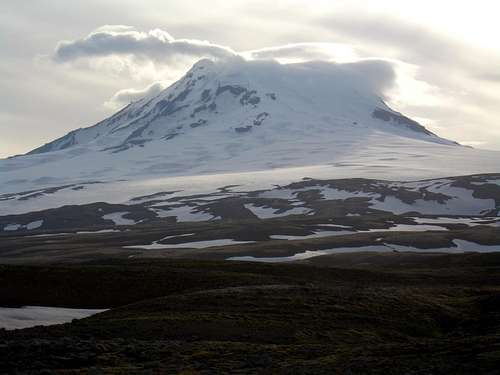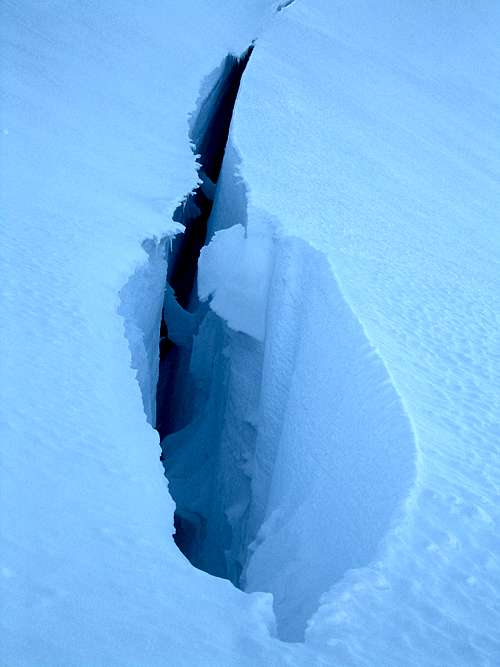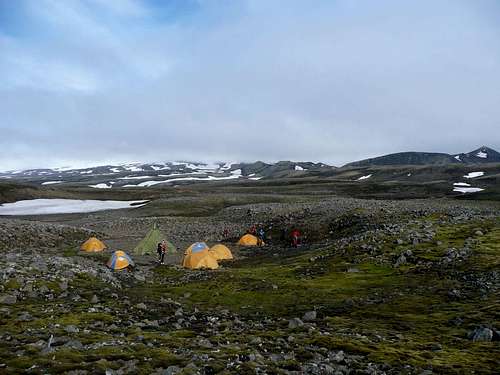-
 23542 Hits
23542 Hits
-
 88.31% Score
88.31% Score
-
 27 Votes
27 Votes
|
|
Mountain/Rock |
|---|---|
|
|
71.08330°N / 8.183°W |
|
|
extraterritorial |
|
|
Mountaineering |
|
|
Summer |
|
|
7470 ft / 2277 m |
|
|
Overview
Beerenberg is the world's northernmost volcano, situated on the North Atlantic island of Jan Mayen, a Norwegian extraterritorial possession. Jan Mayen in turn is located on a more or less straight line between Iceland and Svalbard/Spitzbergen.
Beerenberg is an arctic mountain, and although not extremely high, covered by glaciers on all sides.
Beerenberg has long been thought extinct, but has recently displayed vivid signs of volcanic activity: 1970 and 1984/85 were years where Beerenberg erupted on its north west flanks.
The barren island of Jan Mayen was discovered in 1607 by Henry Hudson on one of his voyages in search of the North West Passage. It is named after the Dutch whaler-captain Jan Jacobs May van Schellinkhout, who had landed there for the first time in 1614, seven years after the island had been discovered.
The name "Beerenberg" is also Dutch, a reminiscence of the island's history as a whaling outpost and occasional habitat of polar bears.
Beerenberg was climbed first by a scientific party between 9th and 11th August 1921: Swiss meteorologist Paul-Louis Mercanton, English polar explorer and geologist James Mann Wordie and naturalist Thomas Charles Lethbridge are named as the first ascenders. It is unclear, however, if they "only" reached the crater rim or if they set foot on Haakon VII toppen, the highest tip along the crater rim.
Ever since, Beerenberg has been climbed only 18 times by people from the nearby meteo station (all of them have been Norwegians so far).
Beerenberg was climbed by foreign tourists first on 30 June, 2008. Together with 5 Norwegians in the summit party there were 2 Germans - Wolfgang Schaub, 64 years old, second oldest ever on the summit; and Roman Zarmutek - and 1 Icelandic - Rúnar Karlsson.
For more information, pictures, and a full trip report see https://www.summitpost.org/trip-report/465076/first-foreigners-on-beerenberg-or-just-try-something-new.html
Getting There
Jan Mayen is and has always been - in the strict sense of the word - uninhabited, meaning that there never has been a continuous settlement on the island. There is, however, a meteorological station on the island since 1921, manned with 18 service persons who rotate in half-yearly intervals. Part of the meteorological station is a „Long Range Navigation“ (Loran-C) base, with a 1,585 m long airstrip.As the financial support for the station comes from the US and Norwegian military, the station is under threat to be closed down in response to the soft political climate.
Due to the military mystery surrounding the island it is not readily accessible. There is no commercial traffic linking the island with the outside world. Cruise ships anchor occasionally, so that tourists can have a guided tour to the meteo station, but otherwise the island is "clean" and untouched.
Special permits to enter Jan Mayen can be obtained from Bodø police on mainland Norway, but you should give a convincing (for example a scientific) reason in support of your application.
For the first time in history, www.ecoexpeditions.no has been successful in 2008 to obtain such a permission not only to enter Jan Mayen, but also to climb Beerenberg. This is largely due to Johan Hustadnes, a former stationee at the meteo station and alpine expert who acted as a guide to the group.
Geir Ulstein of www.ecoexpeditions.no plans to repeat the success on Jan Mayen in the years to come.
Transport to and from Jan Mayen is provided by www.boreaadventures.com from Dalvik, Iceland.
Best season in the high arctics is May - June - July.
Red Tape
Jan Mayen is generally off-limits for tourists. Secret landing on Jan Mayen is frowned upon.
There is no rescue facility, doctor, hospital, air transport, hotel and the like for climbers on Jan Mayen.
Beware of crevasses in the upper parts of Prins Olavsbreen, called Bratthenget.
The sparse tundra vegetation deserves special care.
Firewood can be found ashore North Laguna.
Water is problematic. There are practically no springs, and melting water trickles away rapidly.
Camping
There is no accommodation for tourists on the island, and the meteo people refrain from offering such. Hence, camping near to a fresh water stream or close to the glacier's ice is the only means to survive.
You have to carry all food with you.
Since weather conditions on Jan Mayen are generally nebulous to dreadful you can only speculate for sunny spells in between. It is strongly recommended to access capable weather services for semi-reliable forecasts. You should not get misled by clouds surrounding Beerenberg, even when good weather has been forecast: This means there is only a ring of clouds in the lower elevations of the mountain that you can easily break through - and stand in full sunshine.
External Links
www.ecoexpeditions.no
www.hustadnes.net
www.boreaadventures.com
http://de.wikipedia.org/wiki/Jan_Mayen
www.gipfel-und-grenzen.eu and www.gipfel-und-grenzen.de/index.php?sprache=EN





